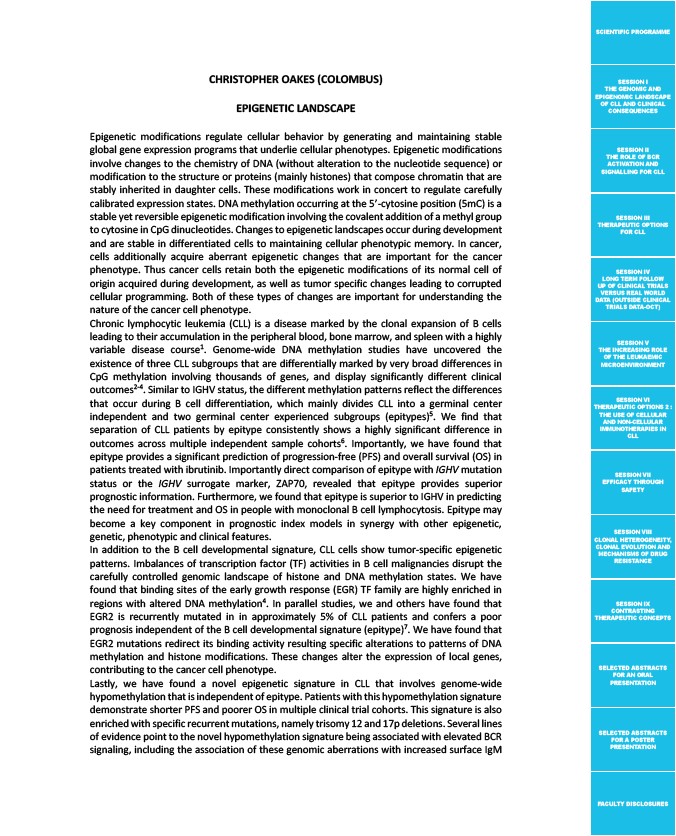
SCIENTIFIC PROGRAMME
SESSION I
THE GENOMIC AND
EPIGENOMIC LANDSCAPE
OF CLL AND CLINICAL
CONSEQUENCES
SESSION II
THE ROLE OF BCR
ACTIVATION AND
SIGNALLING FOR CLL
SESSION III
THERAPEUTIC OPTIONS
FOR CLL
SESSION IV
LONG TERM FOLLOW
UP OF CLINICAL TRIALS
VERSUS REAL WORLD
DATA (OUTSIDE CLINICAL
TRIALS DATA-OCT)
SESSION V
THE INCREASING ROLE
OF THE LEUKAEMIC
MICROENVIRONMENT
SESSION VI
THERAPEUTIC OPTIONS 2 :
THE USE OF CELLULAR
AND NON-CELLULAR
IMMUNOTHERAPIES IN
CLL
SESSION VII
EFFICACY THROUGH
SAFETY
SESSION VIII
CLONAL HETEROGENEITY,
CLONAL EVOLUTION AND
MECHANISMS OF DRUG
RESISTANCE
SESSION IX
CONTRASTING
THERAPEUTIC CONCEPTS
SELECTED ABSTRACTS
FOR AN ORAL
PRESENTATION
SELECTED ABSTRACTS
FOR A POSTER
PRESENTATION
FACULTY DISCLOSURES
CHRISTOPHER OAKES (COLOMBUS)
EPIGENETIC LANDSCAPE
Epigenetic modifications regulate cellular behavior by generating and maintaining stable
global gene expression programs that underlie cellular phenotypes. Epigenetic modifications
involve changes to the chemistry of DNA (without alteration to the nucleotide sequence) or
modification to the structure or proteins (mainly histones) that compose chromatin that are
stably inherited in daughter cells. These modifications work in concert to regulate carefully
calibrated expression states. DNA methylation occurring at the 5’-cytosine position (5mC) is a
stable yet reversible epigenetic modification involving the covalent addition of a methyl group
to cytosine in CpG dinucleotides. Changes to epigenetic landscapes occur during development
and are stable in differentiated cells to maintaining cellular phenotypic memory. In cancer,
cells additionally acquire aberrant epigenetic changes that are important for the cancer
phenotype. Thus cancer cells retain both the epigenetic modifications of its normal cell of
origin acquired during development, as well as tumor specific changes leading to corrupted
cellular programming. Both of these types of changes are important for understanding the
nature of the cancer cell phenotype.
Chronic lymphocytic leukemia (CLL) is a disease marked by the clonal expansion of B cells
leading to their accumulation in the peripheral blood, bone marrow, and spleen with a highly
variable disease course1. Genome-wide DNA methylation studies have uncovered the
existence of three CLL subgroups that are differentially marked by very broad differences in
CpG methylation involving thousands of genes, and display significantly different clinical
outcomes2-4. Similar to IGHV status, the different methylation patterns reflect the differences
that occur during B cell differentiation, which mainly divides CLL into a germinal center
independent and two germinal center experienced subgroups (epitypes)5. We find that
separation of CLL patients by epitype consistently shows a highly significant difference in
outcomes across multiple independent sample cohorts6. Importantly, we have found that
epitype provides a significant prediction of progression-free (PFS) and overall survival (OS) in
patients treated with ibrutinib. Importantly direct comparison of epitype with IGHV mutation
status or the IGHV surrogate marker, ZAP70, revealed that epitype provides superior
prognostic information. Furthermore, we found that epitype is superior to IGHV in predicting
the need for treatment and OS in people with monoclonal B cell lymphocytosis. Epitype may
become a key component in prognostic index models in synergy with other epigenetic,
genetic, phenotypic and clinical features.
In addition to the B cell developmental signature, CLL cells show tumor-specific epigenetic
patterns. Imbalances of transcription factor (TF) activities in B cell malignancies disrupt the
carefully controlled genomic landscape of histone and DNA methylation states. We have
found that binding sites of the early growth response (EGR) TF family are highly enriched in
regions with altered DNA methylation4. In parallel studies, we and others have found that
EGR2 is recurrently mutated in in approximately 5% of CLL patients and confers a poor
prognosis independent of the B cell developmental signature (epitype)7. We have found that
EGR2 mutations redirect its binding activity resulting specific alterations to patterns of DNA
methylation and histone modifications. These changes alter the expression of local genes,
contributing to the cancer cell phenotype.
Lastly, we have found a novel epigenetic signature in CLL that involves genome-wide
hypomethylation that is independent of epitype. Patients with this hypomethylation signature
demonstrate shorter PFS and poorer OS in multiple clinical trial cohorts. This signature is also
enriched with specific recurrent mutations, namely trisomy 12 and 17p deletions. Several lines
of evidence point to the novel hypomethylation signature being associated with elevated BCR
signaling, including the association of these genomic aberrations with increased surface IgM